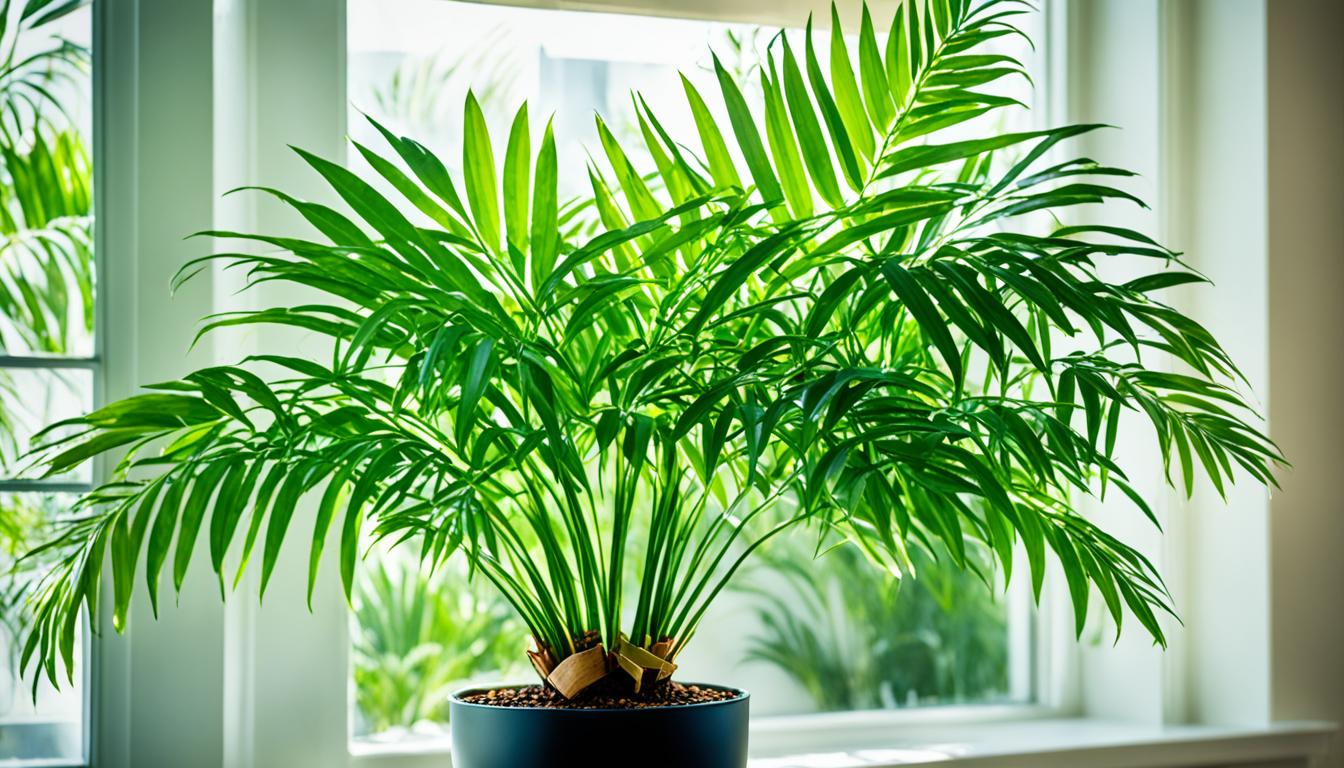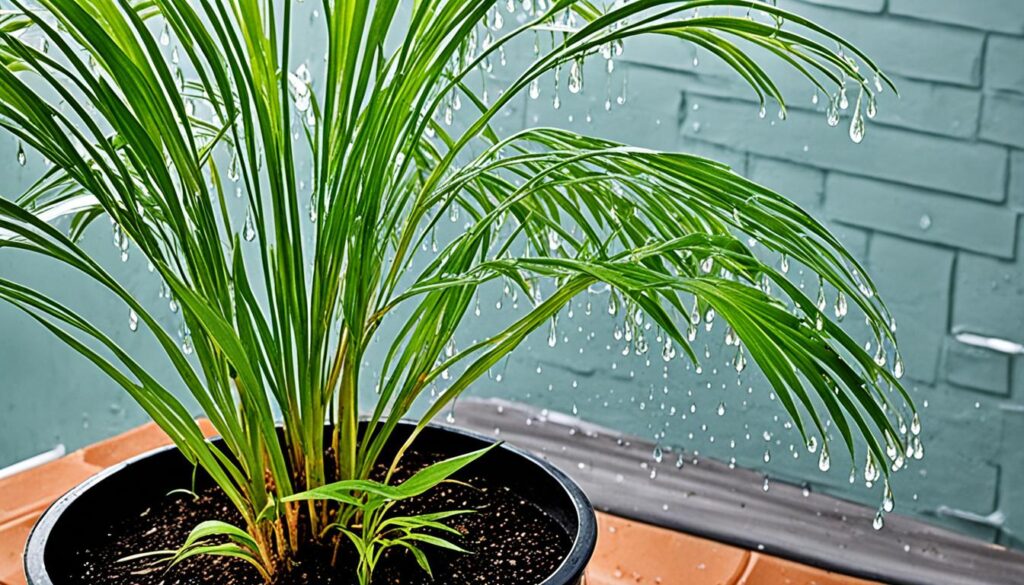Indoor plants are now a big trend for those living in apartments. They make small spaces feel like nature and are good for health. The Parlour Palm is a favorite because it looks elegant and delicate. This guide is for everyone. It helps both new and experienced plant owners. You’ll learn how to take good care of a Parlour Palm.
Key Takeaways:
- Parlour Palms are popular indoor houseplants for apartment dwellers, thanks to their elegant appearance and health benefits.
- These plants are known for their air-purifying qualities and are considered pet-friendly, making them suitable for households with pets.
- Parlour Palms have specific requirements when it comes to light, watering, fertilization, and potting.
- They can be propagated through stem cuttings or seeds, and proper care and monitoring are essential to prevent pests and diseases.
- With the right care, Parlour Palms can thrive and beautify your apartment space for years to come.
Why Do We Love the Parlour Palm For Apartments?
The Parlour Palm is a favorite for apartments. It makes any home look and feel better. It’s not only pretty. It also makes apartment living better in many ways.
Is the Parlour Palm Air-Purifying?
Yes, the Parlour Palm cleans the air. It’s great for indoors, especially apartments. It takes toxins out of the air. This makes your home healthier and nicer to live in.
“With its lush foliage, the Parlour Palm not only brings natural beauty to my apartment but also helps purify the air, making it a refreshing and comfortable place to live.” – Emma, apartment resident
Is the Parlour Palm Pet Friendly?
Yes! The Parlour Palm is safe for pets. It’s not toxic, so pets can nibble without harm. It’s the best for pet owners. They can have pretty plants without worrying about safety.
How Big Does the Parlour Palm Get?
The Parlour Palm stays small indoors. It grows to be 2 to 6 feet tall.
It’s great for small spaces. Its leaves spread out but don’t take over the room.
The Parlour Palm makes homes look lush and green. It beautifies your space and cleans the air. It also keeps you and your pets safe.
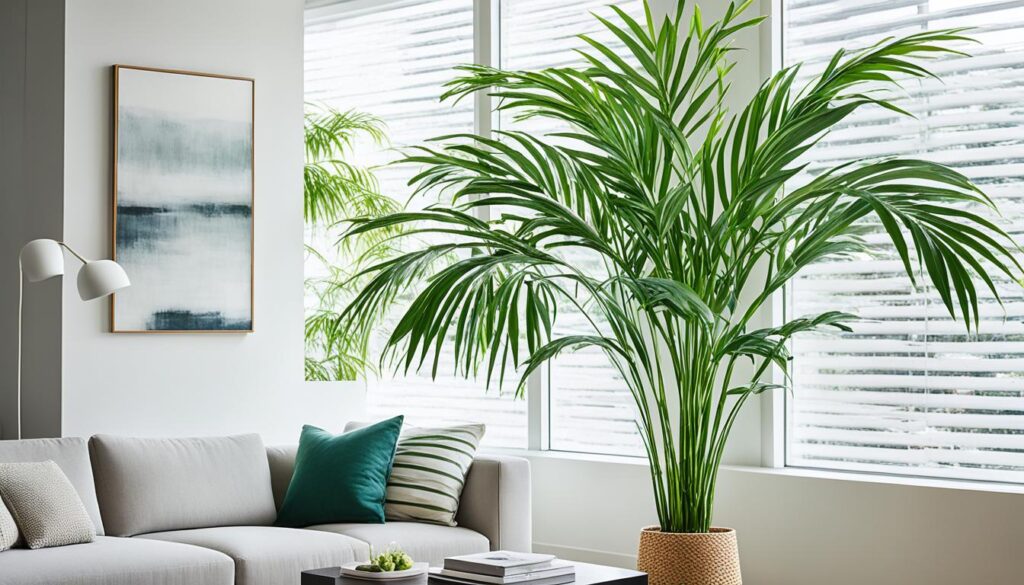
How to Grow a Parlour Palm – Learn to Grow this Indoor Beauty
Growing a Parlour Palm is fun and makes your home look great. Whether new or expert, follow these tips to care for your Parlour Palm well.
Choosing the Right Pot and Soil
Start by picking the right pot and soil. Use a pot with holes to drain water. It should be bigger than the plant’s roots to let them grow.
Parlour Palms need soil that drains well. Use a mix or make your own with peat moss, perlite, and sand. This mix helps keep the right balance of moisture.
Providing Adequate Light
Parlour Palms like bright, indirect light. Keep it near a north window or away from a harsh sun window. Don’t let the sun hit it directly, or its leaves will hurt.
If your room is dim, use lights. Fluorescent or LED lights work well for Parlour Palms.
Watering and Humidity
Watering right is key for your palm. Water when the soil’s top inch is dry. It’s better to under-water than over-water to avoid root rot.
These palms love moist air. Use a water tray or humidifier near it. Spraying the leaves sometimes also helps.
Nutrition and Fertilization
Feed your palm every 2-4 weeks in spring and summer. Use half-strength liquid fertilizer. Don’t feed it in fall and winter.
Follow the fertilizer instructions carefully. Too much can harm your palm. When in doubt, use less.
Pruning and Maintenance
Prune to keep your palm pretty. Take off yellow or brown leaves. Cut back long stems for thicker growth. Additionally, it’s important to regularly check for pests and diseases that might affect your palm’s health. Implementing sago palm care and maintenance practices such as ensuring proper drainage and providing adequate sunlight can significantly improve its vitality. Finally, consider fertilizing your palm during the growing season to promote lush, green foliage and strong growth.
Clean the leaves with a wet cloth to keep your palm dust-free.
Propagation
You can make more palms by dividing or seeds. Split big plants when repotting. Plant each piece in its own pot.
Or, grow palms from seeds. Get seeds from your plant, put them in seed mix, and keep them warm and moist.
Monitoring for Pests and Diseases
Check your palm for bugs like spider mites and mealybugs. If you see bugs, use soap or oil to get rid of them.
Watch out for diseases like fungus or root rot. Water properly to avoid these problems. Act fast if you see an issue.
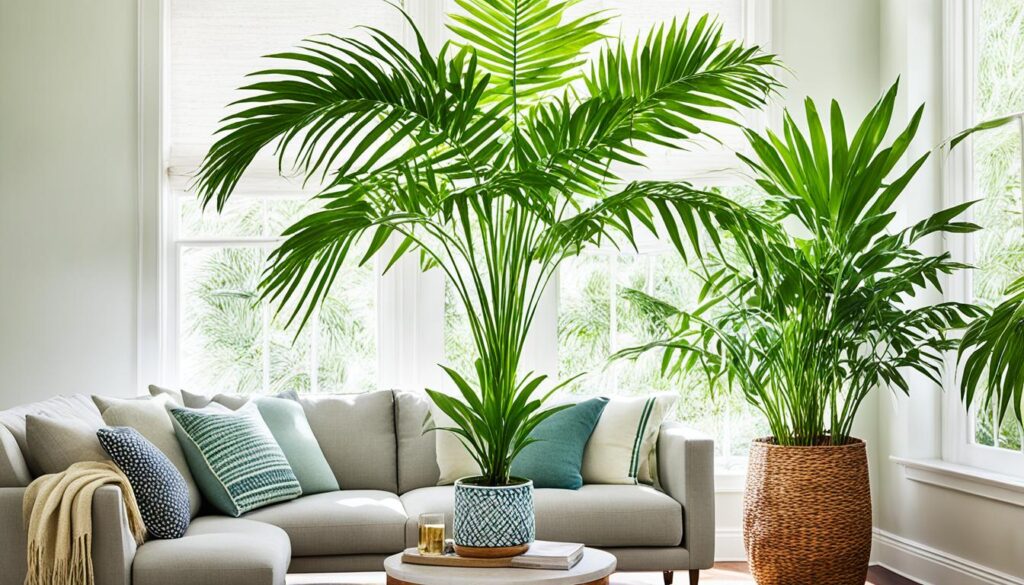
Appearance of Parlour Palm
The Parlour Palm (Chamaedorea elegans) is a stunning indoor plant. It makes any space look elegant.
Its leaves are special because they have many small leaflets. These make the palm look feathery and pretty. The green color of the leaves adds freshness.
The stem is thin and shiny. As it grows, it makes the palm look graceful. Over time, the stem gets slightly woody. This makes the palm look strong.
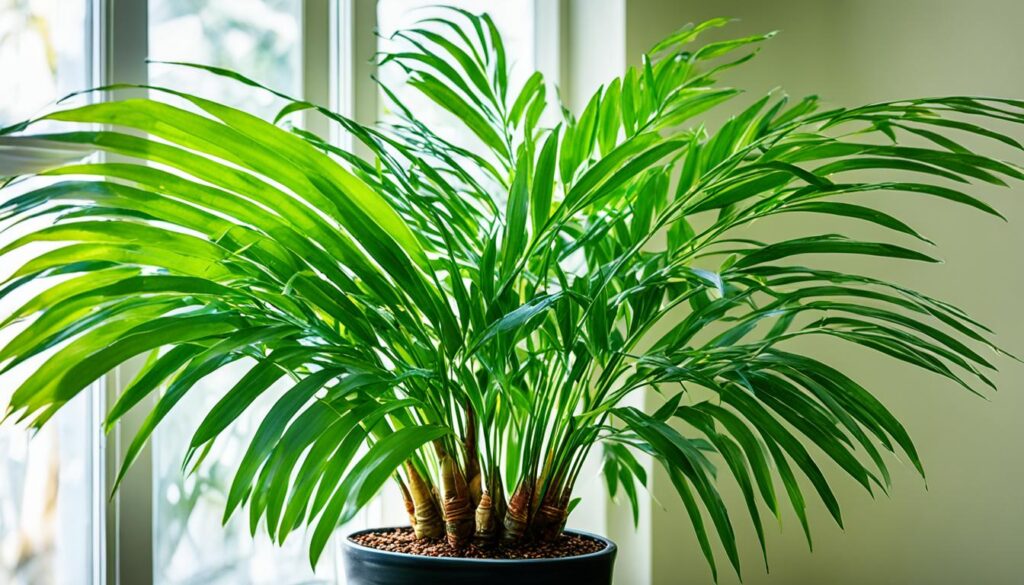
This palm is small and fits well in tight spots. It usually grows 2 to 6 feet tall. It’s perfect for putting on tables or as a room’s centerpiece.
It stands out by itself or with other plants. The Parlour Palm adds beauty wherever it goes.
Light Requirements for Parlour Palm
Parlour Palm needs good light to grow well. Knowing its light needs makes it stay healthy and live long.
This plant loves bright, but not direct, light. It’s happy near a window that doesn’t face the sun straight on.
If your room is dark, adding a light helps. LED lights work great for these plants. Put the light about 12 inches up to be like the sun.
Think about where it comes from. It grows under big trees in nature. So, making a similar shady spot at home is ideal.
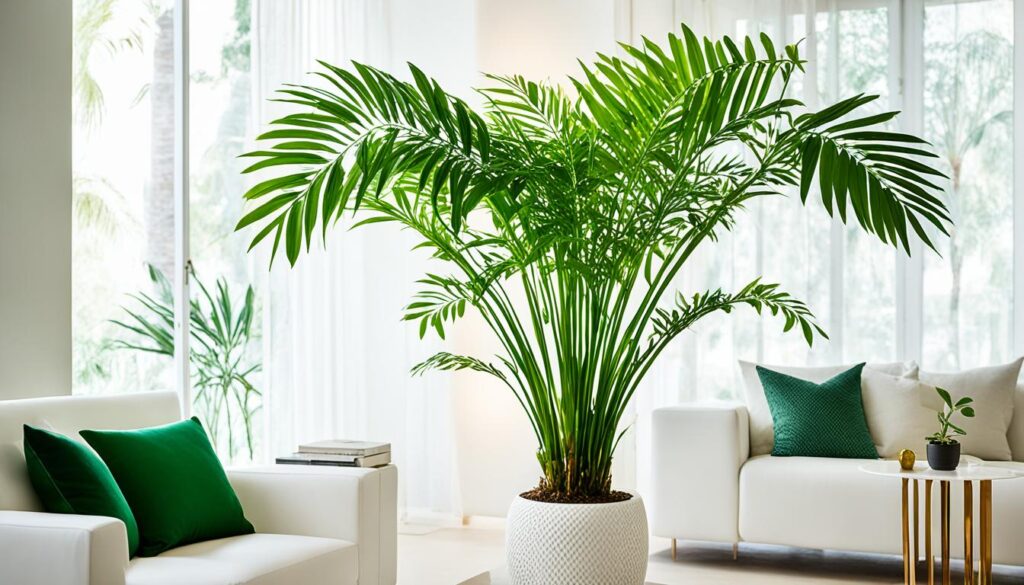
Watering Requirements of The Parlour Palm
Proper watering is key for your Parlour Palm’s health. Knowing its needs helps avoid common problems.
Guidance on Watering Frequency and Techniques
Finding the right balance is vital. Too much or too little water harms the plant. Here’s how to water correctly:
- To check moisture, put your finger in the soil until the first knuckle. Don’t water if it’s damp. Water if it’s dry.
- Water well until it drains out the bottom. This helps the whole root system.
- Don’t let the pot sit in water. Remove extra water to avoid root rot.
Watering needs change with temperature, humidity, and plant size. Watch the soil and adjust water as needed.
Signs of Overwatering vs. Underwatering
It’s important to know the signs of too much or too little water.
Signs of too much water include:
- Yellow or droopy leaves
- Bugs in the soil
- Wet soil
- Root rot or bad smells
If you see these, water less often. Use a pot that drains well.
Signs you’re not watering enough include:
- Leaves wilt or droop
- Leaf tips are dry or brown
- Soil is very dry
If leaves drop or soil dries out, water more. Ensure the roots get enough water.
Fertilizing Parlour Palms
Fertilizing is key for growing healthy Parlour Palms. They need nutrients from fertilizers to grow well and look bright. But, it’s vital to pick the right one and use it the right way. Using it wrong can hurt the plant.
Recommended Fertilizer for Parlour Palms
For these palms, a balanced liquid fertilizer is best. Choose one made for indoor plants. A 10-10-10 or 20-20-20 mix is good.
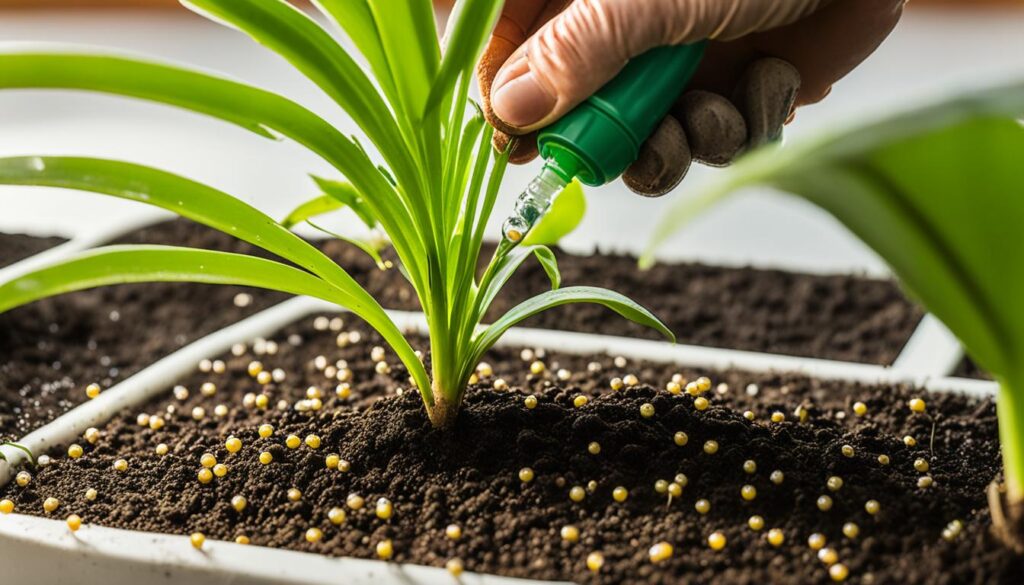
This kind of fertilizer gives steady nutrients. This helps the plants grow right without any nutrient issues. Always follow what the label says for how much to use and how to mix it.
Fertilize most in spring and summer. This is when they grow a lot. In cold months, fertilize less because they don’t grow much then.
Make sure the soil is a bit wet before adding fertilizer. This keeps nutrients in the soil and helps roots take them in well.
Don’t fertilize too much. Too much can put too much salt in the soil. This is bad for the plant. If leaves turn yellow or brown at the tips, you might be using too much.
Fertilizing right, along with good water and light, makes Parlour Palms beautiful indoors.
Potting Parlour Palms
Potting parlour palms needs some important steps. You need the right size pot and the best soil. Also, knowing when to change the pot is key for healthy and happy plants.
Choosing the Right Pot Size
Picking the right pot size for your parlour palm is crucial. The pot should have enough room for the roots to grow. A small pot stops growth. A big pot might lead to too much water.
You should get a pot that is 2-4 inches bigger than the current one. This gives your parlour palm space to grow but not too much soil.
Using the Right Potting Mix for Parlour Palms
The soil you use is very important for your parlour palm’s health. Use a mix that drains well to avoid too much water and root problems. Choose soil made for indoor plants or palms. It has what your plant needs.
A good mix has peat moss, perlite, and vermiculite. These keep the soil moist but not wet.
Repotting When Necessary
Parlour palms grow and sometimes need a new pot. If you see roots coming out of the pot, it’s time. Or if the plant stops growing or tips over easily.
To repot, take the palm out gently. Trim any bad roots. Put it in a new pot with new soil. Water it well to help it settle in.
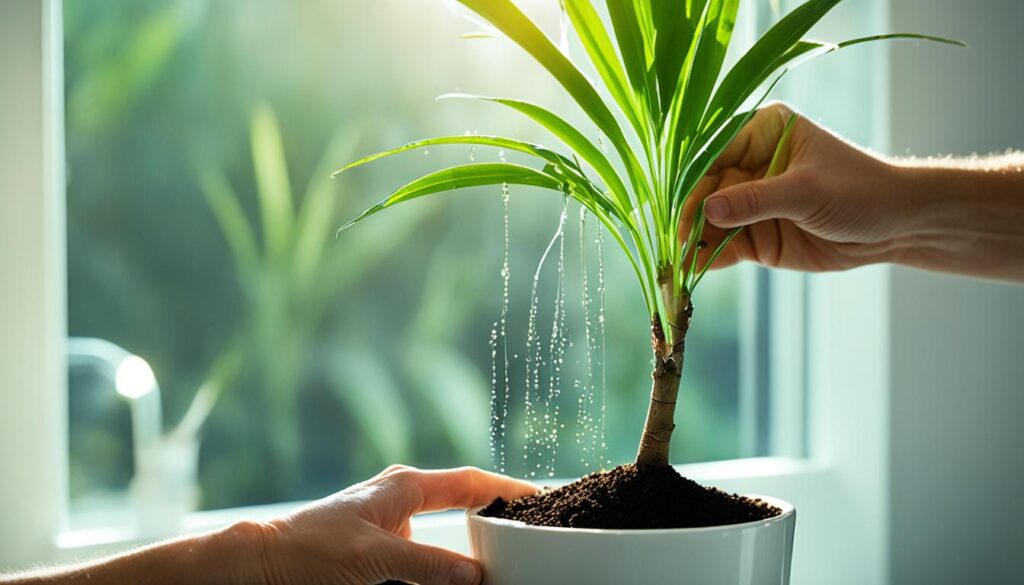
Propagating Parlour Palms
Propagating Parlour Palms helps your indoor plant collection grow. It’s great for sharing with others, too. You can use stem cuttings or seeds for propagation.
Stem Cuttings Or Seeds?
Stem cuttings are quick and reliable. You take a healthy piece from a Parlour Palm. Then you make it grow roots as a new plant. This way, you get a plant just like the parent.
Using seeds is also fun and rewarding. You get to see the plant grow from start to finish. But remember, seeds need more time and patience to grow.
Division Of A Parlour Palm
Another way to make more plants is by division. This works best for big plants with many stems. You make new plants from these offshoots.
Do this when you’re repotting. Carefully take the plant out and separate the offshoots. Make sure each piece has roots and leaves for growth.
For more details on these methods, here are some steps:
| Propagation Method | Step-by-Step Instructions |
|---|---|
| Stem Cuttings |
|
| Division |
|
By using these methods, you can have more Parlour Palms. You can decorate your home or give them away.
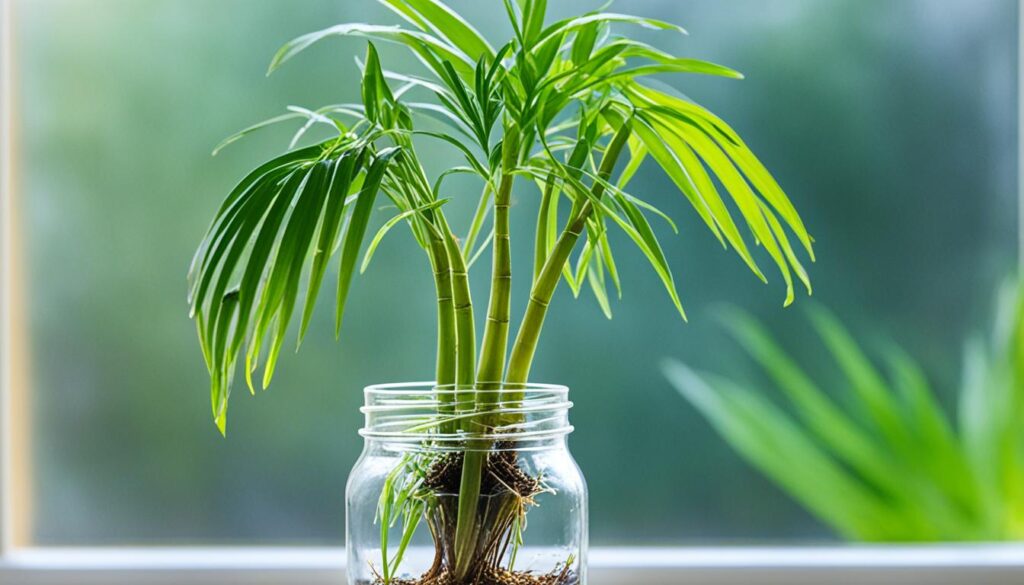
Growth and Development of Parlour Palms
Parlour Palms start small but grow into beautiful indoor plants. Knowing about their growth is key to good care.
These palms take years to get big. At first, they’re tiny seedlings. Then, they grow bigger and prettier with good care.
Light, water, warmth, and food affect their growth. These plants need the right care to grow well.
Place your palm where it gets light but no direct sun. Direct sunlight can harm the leaves. The soil should be moist, not soaked. Let it dry a bit before you water again. A temperature of 60°F to 75°F is best.
Parlour Palms grow slowly but look great with time. Watch their growth and change their care as needed. With some love, your palm will thrive for years.
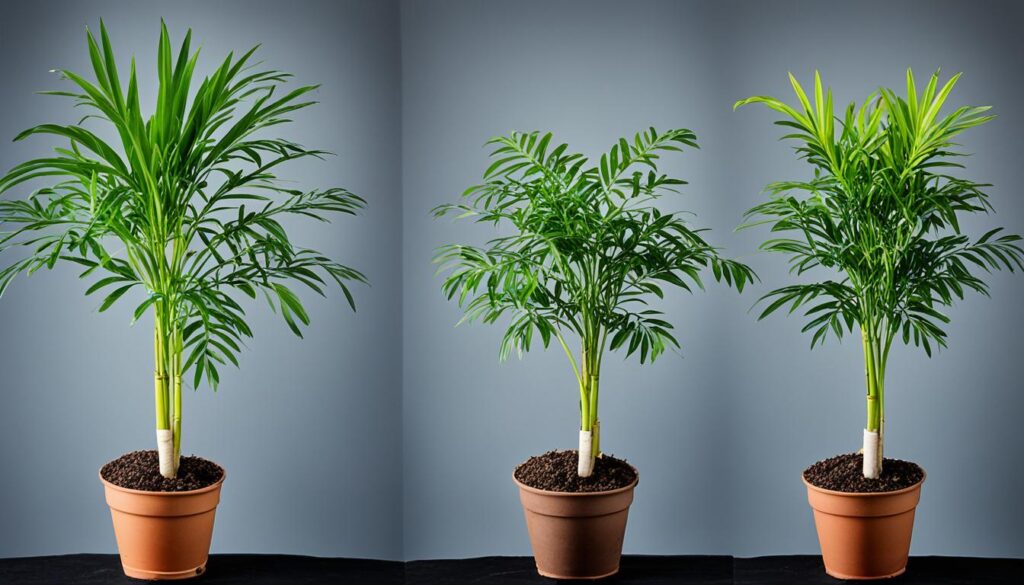
Dealing with Pests and Diseases in Parlour Palms
Parlour Palms are beautiful and elegant inside homes. But they can get sick or attacked by pests. It’s key to watch out and act fast if problems show up. Here I’ll talk about the pests and diseases that can bother Parlour Palms. I’ll also share how to prevent and handle them.
Common Pests
Some pests that love Parlour Palms are:
- Spider Mites: These tiny bugs suck sap from leaves, turning them yellow and stopping growth. Spiderwebs on leaves show they are there.
- Mealybugs: Small, white bugs that eat plant sap and leave white, fluffy stuff. They make the plant weak and cause leaves to fall off.
- Scale Insects: They look like small, brown or black bumps. They drink the plant’s sap, making it grow poorly and leaves to yellow.
It’s very important to find pests early. Always check your plants for pests and do something right away if you see them.
Disease Prevention
Plants can get sick from fungal infections and root rot too. Here’s how to stop this:
- Make sure your plants aren’t too close. They need space for air to flow well.
- Don’t overwater your plants. Too much water helps fungus grow. Let the soil dry a bit before you water again.
- Use soil that drains well to avoid too wet roots. Wet roots can cause root rot.
Doing these things can help keep your Parlour Palms healthy and free from pests and diseases.
Common Parlour Palm Pests
Parlour Palms are strong and battle pests well. But, some pests might still bug them if we’re not careful. It is key to know how these pests look, the harm they do, and how to stop or fix these issues. This keeps your Parlour Palms happy and pretty.
1. Spider Mites: These tiny bugs with eight legs love indoor plants, like Parlour Palms. They hang out under leaves and make fine webs. They drink plant sap, turning leaves yellow and slowing growth. Keep them away by misting leaves and keeping air moist. If they show up, wash them off with soapy water or special bug soap.
2. Mealybugs: Mealybugs look like small, white, fluffy spots on stems and leaves. They also drink sap, making plants grow slowly and leaves turn yellow. Check your plants often for these bugs and pluck off any sick parts. A cotton swab with rubbing alcohol can help wipe them away. Use bug killer sprays for bad cases.
3. Scale Insects: Scale insects are tiny, hard bugs in colors like brown or white. They suck sap too, causing leaves to yellow, fall, and get sticky. Check your plants often and clean off any bad parts. Use plant-safe oils or special sprays to beat them.
4. Aphids: Aphids are tiny bugs that come in colors like green, black, and brown. They feast on sap and make leaves twist, plants grow poorly, and leave a sticky mess. Keep an eye out for them and clean off any bad parts. Wash them off with water or bring in bug-eating friends like ladybugs.
5. Fungus Gnats: Fungus gnats look like tiny flying bugs and love wet soil. They can bug your indoor plants, including Parlour Palms. Their babies eat plant roots and dirt. To avoid them, don’t water too much. Let the soil dry a bit. Use sticky traps for adults and tiny helpful worms for babies.
| Pest | Prevention | Treatment |
|---|---|---|
| Spider Mites | – Regularly mist leaves and provide humidity – Inspect plants for signs of infestation – Avoid overcrowding and improve air circulation | – Spray with mild liquid soap and water solution – Use insecticidal soap as directed |
| Mealybugs | – Regularly inspect plants for signs of infestation – Remove infested leaves and stems – Provide good air circulation | – Use rubbing alcohol to manually remove bugs – Apply horticultural oil or neem oil as directed |
| Scale Insects | – Regularly inspect plants for signs of infestation – Remove affected leaves and stems | – Apply horticultural oil or neem oil as directed – Consider using chemical insecticides for severe infestations |
| Aphids | – Regularly inspect plants for signs of infestation – Remove affected leaves and stems – Introduce natural predators | – Wash away aphids with a strong stream of water – Use insecticidal soap as directed |
| Fungus Gnats | – Allow soil to dry out slightly between waterings – Avoid overwatering – Use yellow sticky traps to capture adults | – Introduce beneficial nematodes to control larvae – Apply appropriate chemical treatments as directed |
Natural Predators
Keeping Parlour Palms healthy is important. It’s best to try natural pest control methods first. Natural predators like some insects help control pests.
Adding these predators to your indoors keeps the ecosystem balanced. It stops pest problems in your Parlour Palms.
Isolate Infected Plants
If your Parlour Palms have pests, separate them fast. This keeps the pests from spreading to other plants.
Put the sick plant in a different room. This helps you fight the pests without risking other plants.
Chemical Treatment
Sometimes, you may need chemicals if other methods fail. Pick sprays safe for indoor plants and follow directions.
Be safe when using chemicals. Wear protective gear, use the right amount, and keep the area well-ventilated.
Disease Prevention For Parlour Palms
Keeping Parlour Palms healthy is key. Following these tips helps minimize disease risk for them. This creates a good environment for your Parlour Palms.
- Proper water management: Too much water causes root rot. Not enough can stress the plant. Water your Parlour Palm just right. Let the soil dry a bit before you water again. Keep the pot free from too much water.
- Good airflow: Good airflow stops too much moisture. It keeps fungi from growing. Put your plant where air can move around it well. This keeps your plant’s surroundings dry and healthy.
- Regular maintenance: Check your Parlour Palm for disease signs like spots or sick leaves. Remove any bad leaves quickly. Also, keep the area clean by picking up fallen leaves.
Watch your Parlour Palms for any disease signs. Use these tips to keep them looking great. Enjoy having healthy Parlour Palms indoors.
Tips for Maintaining Parlour Palms
Keep your Parlour Palms healthy with proper care. Follow these tips for growth and life.
Wiping Leaves
It is important to clean the leaves. This removes dust and stops pests.
Wipe gently with a soft, wet cloth. Your Parlour Palm will look fresh and alive.
Outdoor Exposure
Parlour Palms do well inside, but benefit from being outside sometimes. Put them in a shady spot when the weather is nice.
This outdoor time helps them grow strong. But, keep them out of direct sun to avoid damage.
Adjusting Watering Schedule
Watering needs change with the seasons. They need more water when it is warm.
In colder months, water them less. Make sure the top inch of soil is dry before watering.
By caring for your Parlour Palms this way, they will stay beautiful for many years.
Tips for Successful Overwintering of Parlour Palm
Keeping your Parlour Palms healthy during winter is important. Here’s how to take care of them when it’s cold:
- Temperature control: Parlour Palms like it warm. Keep them away from cold spots. They do best at 60-70°F (15-21°C).
- Adjust care routines: In winter, Parlour Palms grow slower and need less water. Let the soil’s top dry before watering again. Avoid giving too much water to stop root rot.
- Increase humidity: Homes get drier in winter because of heating. Use a humidifier or a water tray near your palm to raise the air’s moisture.
- Monitor light exposure: Parlour Palms need bright, indirect light even in winter. Put them near a south-facing window or use artificial lights if necessary.
- Minimize fertilization: Fertilize your Parlour Palms less in winter since they grow more slowly. Lower how often and how much you fertilize.
Follow these tips to keep your Parlour Palm looking beautiful all winter long.
Growing Parlour Palm from Seed
Do you want to grow your own Parlour Palms? It’s exciting to see them grow from seed. With some good steps and patience, you can make seeds grow into lovely indoor plants.
Just follow these instructions to grow Parlour Palms from seeds:
- Seed Collection: First, get fresh Parlour Palm seeds. You can get them from grown plants or buy them online or from stores.
- Seed Preparation: Clean the seeds gently. Wash them with lukewarm water. Be careful not to hurt them.
- Germination Technique: Use the baggy technique to start. Wet a paper towel or cheesecloth, put seeds on it, and cover them. Then, place it in a plastic bag but keep it open for air.
- Warm and Dark Environment: Keep the bag with seeds somewhere dark and warm. A place like the top of a refrigerator works well. This helps the seeds start to grow.
- Patience and Monitoring: Make sure the seeds stay moist but not too wet. Don’t open the bag too much. It could mess up the moisture or cause mold. Wait patiently, it may take weeks or months.
- Transplanting: Once seeds grow roots and shoots, move them to their pots. Use good soil. Keep them warm and where there is light but no direct sun.
- Care and Maintenance: Give them the right light, water, and food to grow strong. Don’t water too much to avoid root rot. Slowly let them get used to more light.
- Watch Them Flourish: With your care, the seedlings will become beautiful Parlour Palms. They will make your home more beautiful and green.
Enjoy watching your Parlour Palms grow from seeds. It’s great to see these amazing plants grow from a tiny seed into beautiful leaves.
Varieties of Parlour Palm
There are many types of Parlour Palms to choose from. Each one is special in its way. These plants make any area look nice. They are great for places with not much space. Let’s look at some popular types:
Chamaedorea elegans
The Neanthe Bella Palm or Chamaedorea elegans is small and cute. It doesn’t grow too big. It has soft, green leaves that hang down. It makes indoor spaces look better. This plant is perfect for small places. It looks pretty on tables and shelves.
Chamaedorea erumpens
The Bamboo Palm is also called Chamaedorea erumpens. It looks a lot like bamboo. It has thin stems and light green leaves. This plant can get really tall. It’s good for big rooms or empty spaces. It makes any area feel peaceful and fresh.
You can choose either the Chamaedorea elegans or the Chamaedorea erumpens. Both are great types of Parlour Palm. These plants make your home more beautiful. They bring the calm of nature inside. With some care, they will grow well and make your room lovely.
FAQ
Q: Why do we love the Parlour Palm for apartments?
A: The Parlour Palm is popular for apartments. It looks elegant and delicate.
It improves air and is safe for pets.
Q: Is the Parlour Palm air-purifying?
A: Yes, it can remove toxins from the air. This makes your home healthier.
Q: Is the Parlour Palm pet-friendly?
A: Yes, it’s safe for pets. Dogs, cats, and other pets won’t be harmed.
Q: How big does the Parlour Palm get?
A: It grows to 4 to 6 feet tall. It spreads 2 to 3 feet wide.
It’s perfect for indoor spaces.
Q: How to grow a Parlour Palm – Learn to grow this indoor beauty?
A: Use the right pot and soil. Give it light, water, and nutrients.
Prune when needed. Watch for pests and diseases.
Q: What is the importance of choosing the right pot and soil for growing a Parlour Palm?
A: The right pot and soil help it grow well. They keep its roots healthy.
Use a pot with holes and rich soil.
Q: How to provide adequate light for a Parlour Palm in an indoor setting?
A: Place it where it gets bright, indirect light. Use a grow light if needed.
Q: What are the watering and humidity requirements for a Parlour Palm?
A: Water when the soil’s top inch is dry. Use misting or a humidifier for humidity.
Q: What are the nutrition and fertilization requirements for a Parlour Palm?
A: Feed it with diluted liquid fertilizer. Do this every 2-4 weeks when it grows.
Q: How to prune and maintain a Parlour Palm?
A: Cut off yellow or brown leaves. Trim damaged fronds and dust the leaves.
Q: How to propagate a Parlour Palm?
A: You can use stem cuttings or division. Both need healthy plants or sections with roots.
Q: How to monitor for pests and diseases that can affect a Parlour Palm?
A: Look for pests like spider mites and diseases like rot. Treat them early.
Q: What does the appearance of a Parlour Palm look like?
A: It has arching, feathery fronds. They’re green and arranged gracefully.
Q: What are the light requirements for a Parlour Palm?
A: It likes bright, indirect light. Avoid full shade to prevent weak growth.
Q: How often should a Parlour Palm be watered?
A: Water when the soil’s dry. Don’t over-water to avoid root rot.
Q: What are the signs of overwatering and underwatering in a Parlour Palm?
A: Overwatering causes wilting and yellow leaves. Underwatering leads to dry edges and drooping.
Q: How important is fertilizing a Parlour Palm?
A: Fertilizing gives it needed nutrients. It helps the palm stay healthy and grow well.
Q: How to choose the right pot size for potting Parlour Palms?
A: Pick a pot that fits the root ball well. It should allow for growth.
Q: What type of potting mix should be used for Parlour Palms?
A: Use a mix that drains well. Peat moss, perlite, and vermiculite are good.
Q: When and how to repot Parlour Palms?
A: Repot when it’s rootbound, about every 2-3 years. Use a larger pot with fresh soil.
Q: What are the methods for propagating Parlour Palms?
A: Use stem cuttings or division. Both methods work well for growing new palms.
Q: What are the growth stages of Parlour Palms?
A: They start as seedlings and grow into mature plants. This takes years and proper care.
Q: How to deal with pests and diseases that can affect Parlour Palms?
A: Check for pests like mites. Use pest control if needed. Prevent diseases with good care.
Q: What are the common pests that can infest Parlour Palms?
A: Look out for spider mites, mealybugs, and scale insects. Treat them quickly.
Q: Are there natural predators that can help control pests in Parlour Palms?
A: Ladybugs and lacewings eat pests. They help keep your palm healthy.
Q: How to isolate infected plants to prevent the spread of pests?
A: Keep sick plants away from healthy ones. Do this until pests are gone.
Q: When should chemical treatments be used for severe pest infestations in Parlour Palms?
A: Use chemicals when organic methods fail. Follow the product’s instructions carefully.
Q: How to prevent diseases in Parlour Palms?
A: Water right, allow air flow, and clean up. This helps avoid diseases.
Q: What are the tips for maintaining the health and appearance of Parlour Palms?
A: Wipe leaves, provide outdoor time, adjust water, and winter care. This keeps them healthy.
Q: What are the tips for successful overwintering of Parlour Palms?
A: Control temperature and care in winter. Avoid cold drafts and keep them warm.
Q: How to grow Parlour Palms from seeds?
A: Soak seeds, sow in good soil, keep moist. Provide warmth and light for germination.
Q: What are the different varieties of Parlour Palm?
A: There are many types. Chamaedorea elegans and erumpens are popular for their looks.

